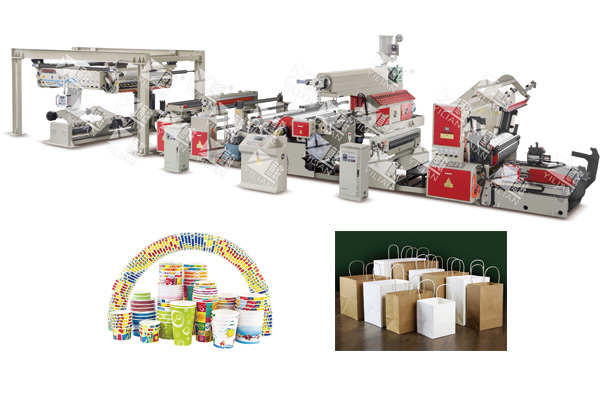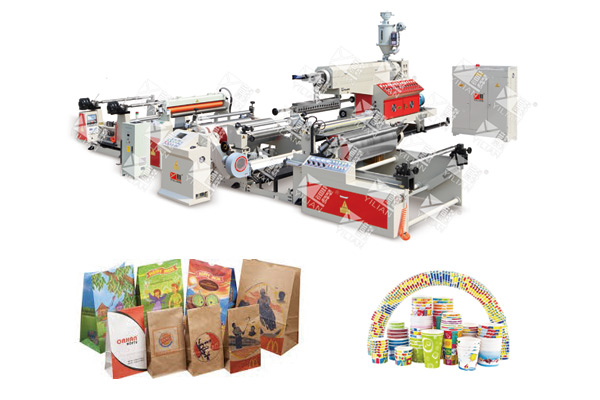What is the difference between extrusion coating and lamination?
Datetime: 2/21/2025 10:27:00 AM Visit: 327
In the field of material processing and manufacturing, extrusion coating and lamination are two widely - used techniques, each with distinct features. Despite their superficial similarities, a deeper analysis reveals substantial differences between them. And the Extrusion Coating Lamination Machine plays an important role in both of these processes.
1. Process Principles
- Extrusion coating is a manufacturing process where a molten thermoplastic resin is transformed into a thin film and extruded directly onto a moving substrate. This hot, freshly - formed film is then firmly pressed onto the substrate by a set of rollers and subsequently cooled to solidify, creating a robust, adherent layer. For example, in the food packaging industry, polyethylene is frequently extruded onto paperboard. This not only imparts moisture - resistance to the paperboard but also provides an additional layer of protection for the packaged food products.
- Lamination, conversely, involves the bonding of two or more layers of materials using an adhesive. The adhesive can be applied in different forms, such as solvent - based, water - based, or hot - melt. Once the adhesive is evenly applied to one of the layers, the layers are pressed together under pressure and, in some cases, heat. This process fuses the layers into a unified, multi - layer structure. For instance, in the production of flexible packaging for consumer goods, different plastic films are laminated together using a carefully selected adhesive to enhance the overall performance of the packaging.
2. Materials Involved
- In extrusion coating, commonly used thermoplastic resins include polyethylene (PE), polypropylene (PP), and ethylene - vinyl acetate (EVA). These resins are selected for their excellent melt - processability and compatibility with a wide range of substrates, which can include paper, metal foil, or various plastic films. The choice of resin depends on the specific requirements of the end - product, such as the desired barrier properties, heat - sealability, and flexibility. The should be able to handle different types of resins according to the production needs.
- Lamination, on the other hand, offers greater material versatility. The adhesives used vary significantly based on the application and the materials being laminated. Solvent - based adhesives provide strong bonding strength but may raise environmental concerns due to solvent emissions during the lamination process. Water - based adhesives, being more environmentally friendly, are a popular alternative, although they may exhibit different bonding characteristics. The materials to be laminated can range from plastic films and paper to fabrics and metal foils, enabling the creation of composite materials with tailored properties.
3. Equipment and Operation
- Extrusion coating demands specialized equipment. An extruder is used to melt and extrude the resin, a die is employed to precisely shape the molten resin into a film, and a series of rollers are responsible for pressing the film onto the substrate and cooling it. This process is typically continuous and operates at high speeds, making it highly efficient for large - scale production. However, setting up and fine - tuning the extrusion process can be complex and requires skilled operators to ensure consistent quality.
- Lamination equipment primarily consists of a coating unit for applying the adhesive and a laminator for pressing the layers together. The operation of lamination is more flexible, allowing for easy adjustment of the adhesive application rate and lamination pressure. This flexibility makes lamination well - suited for small - batch production and the manufacturing of customized products, where different material combinations and bonding requirements can be easily accommodated. The for lamination is relatively more flexible in operation and can meet different customization needs.
4. Product Properties and Applications
- Extrusion - coated products are renowned for their excellent barrier properties. They effectively resist moisture, oxygen, and grease, making them ideal for applications where product preservation is crucial, such as food and beverage packaging. Additionally, their high heat - sealability enables easy and reliable sealing, which is essential for maintaining product freshness and integrity. The products made by Extrusion Coating Lamination Machine** in extrusion coating have important applications in the food and beverage industry.
- Laminated products, on the other hand, are valued for their ability to combine the properties of different materials. For example, in the electronics industry, laminated materials can combine the electrical insulation properties of one material with the mechanical strength of another. In the automotive industry, laminates are used for interior and exterior components, where they can provide a combination of aesthetics, durability, and functionality.
5. Environmental Impact
- Extrusion coating, particularly when water - based primers are used, has a relatively low environmental footprint. The use of water - based primers reduces or eliminates the emission of volatile organic compounds (VOCs) associated with solvent - based systems. Moreover, the resulting coated products are often more recyclable due to their relatively simple structure, which facilitates easier separation and recycling of the materials. The **Extrusion Coating Lamination Machine** in extrusion coating can contribute to environmental protection when using water - based primers.
- Lamination, when using solvent - based adhesives, can contribute to air pollution due to the evaporation of solvents during the manufacturing process. Additionally, the recycling of laminated products can be more challenging because of the presence of multiple layers and adhesives. Specialized separation processes may be required to effectively recycle these materials, adding to the complexity and cost of recycling.
In conclusion, although both extrusion coating and lamination are vital techniques in material processing, their differences in process principles, materials, equipment, applications, and environmental impact make them suitable for different manufacturing requirements. Understanding these differences is essential for manufacturers to make informed decisions and select the most appropriate method for their specific product needs and production goals.










